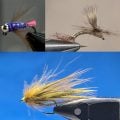Beating the Winter Blues: North Carolina’s Neuse River

Early morning bass. Dakota Richardson photo
THERE ARE MANY famed striper locations along the East Coast. From Montauk to the Outer Banks, fly anglers chase line-siders throughout the fall and into winter. To make things even more challenging, fly fishing for oceanic striped bass can be a difficult when inclement weather hits the coast. Just inland in the Carolinas lives a different breed of stripers, and they can be found in places more friendly to the long rod. North Carolina’s Neuse River is such a place, and it is a hidden treasure that awaits anglers along the east coast.
The Neuse River has its origins near Raleigh, and the trickle that flows below the Falls Dam is a far cry from the seven-mile wide mouth that meets the Pamlico Sound down river from the village of Oriental. However, it is the river’s deep winding, tree lined shores near New Bern that is the winter home of estuarine striped bass that call the Neuse home.
Estuarine stripers can be found in many coastal rivers from North Carolina to Florida, and even a few locations dotting the Gulf. These fish spend much of their lives in the rivers they are born, and do not contribute to migrating ocean stocks. The more famous Roanoke River in North Carolina is a good example of one such location. It is the Neuse, however, that may offer some of the finest year round fishing.
A non-tidal river, the Neuse is unique, and the wind can influence your fishing just like the moon does elsewhere. East winds will push water in and west winds will drop water levels, and both can cause tidal inflow and outflow. Miles of eroded shore line hold countless tree stumps and blow downs, and this abundant cover attracts scores of fish. It is important to keep in mind that the river’s narrow (and deep) channels, sharp drop offs and ledges are generally winter holding areas for cold-water bass.
Striped bass average 15 to 30 inches in the New Bern area, and they are thick and feisty. Although not the giant specimens that can be found offshore, the size and numbers of the Neuse’s fish rivals many areas of the Chesapeake Bay. On good days anglers can land 50 or more fish, and on rarer days, numbers can approach triple digits.
Neuse stripers eat a wide variety of baits, including herring, shad, mullet and menhaden. With the varied diet, they will take many fly patterns. On low light and cloudy conditions fish can be seen busting bait, and also can be blind-casted to with poppers and divers. Eight and nine weight outfits with floating lines are a must, and anglers should always have one within reach. Busting fish can occur on any day and under any condition, offering short, but intense, bouts of action.
Warmer winter days can draw baitfish onto “flats”—mud banks three to six feet deep, and sub-surface flies and intermediate lines are always good to have along. Deep ledges require sinking lines, but you will not need the heavy lines you might be accustomed to on other parts of the coast—250 to 300 grain heads and even type III lines are ideal. Slower flows and sloping banks require slower drops and retrieves. Weighted flies like the standard Clouser Deep Minnow or Half-and-Half are always good choices.
In addition to striped bass, fly fisherman can find a mix of other fresh and saltwater fish on the lower Neuse River—spotted sea trout and redfish can be common on warmer winters, while largemouth bass, pickerel, gar and a variety of jumbo pan fish are often caught on the same shorelines as the stripers.
New Bern is a small city with a regional airport, plenty of accommodations and is located less than two hours from Raleigh, NC. The area has many public boat launches, and anglers can find fish on short runs from those locations. Grab your gear and head to New Bern—the river is friendly, and the fish are willing.
Local Resources
New Bern’s visitor bureau.
Captain Gary Dubiel, Spec Fever Guide Service (252-249-1520).
Captain Joe Ward, Fly Daddy Charters (252-229-4656).











